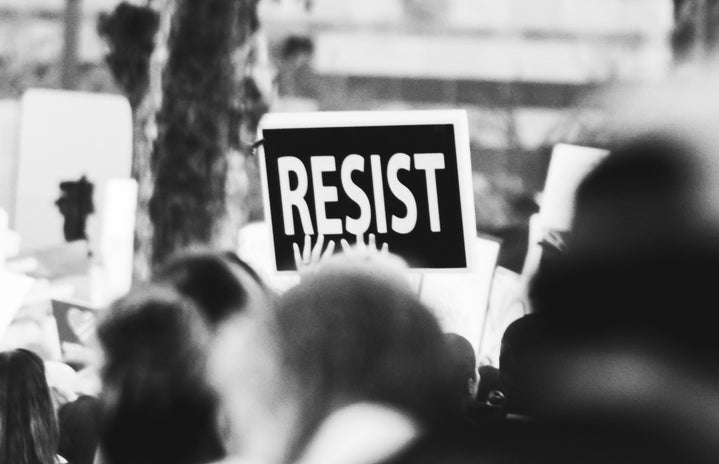On the 18th of January, a video began to circulate on social media showing a group of white high school students surrounding and mocking a Native American elder conducting an annual peaceful protest at the Lincoln Memorial. Through all the varying narratives, media attention, and skewed stories, the most notable image that came to light was that of Nathan Phillips with his drum facing opposite of Nick Sandmann wearing the infamous red Make America Great Again hat.
It was one of those strange moments where you could almost picture it in a history book 50 years from now.
The problem with an image is that it showcases one split second in time, while allowing competing narratives swirl endlessly around it. Some argued that this image was absolutely disgusting. Some rejected this notion, saying that the students were doing nothing wrong.
To give more context to the situation, one must look into the events which unfolded before this particular moment occurred. During that weekend, the March for Life took place for protestors with a pro-life stance. This is the event which originally brought the high school students to Washington, D.C. Following the viral attention towards the photos and videos of Sandmann, young women came forward with videos of the students catcalling and verbally harassing them prior to the events at the Lincoln Memorial. With this information in mind, we can already infer that this group was not here to protest their ideas peacefully, but rather incite rowdiness and spread hate towards those who did not share the same physical characteristics as them. This is a larger theme linked to the school the men attend, Covington Catholic High School, located in Park Hills, Kentucky. During the same day, the annual Indigenous People’s March was occurring. Traditionally, Phillips has been known as a notable Indigenous activist, making his yearly presence one to be expected, and setting the scene for what took place next.
For those that have seen the videos of this event, this additional information can cause the scene to go from uncomfortable to utterly disgusting. But, like in so many other cases, the media and other current influential figures in America stepped in to twist the narrative once more. It’s important to observe the ways in which the days after an event like this one unfold.
First began the immediate rush to justify the situation with regard to the boys’ ages. During this stage, the repeated idea became, ‘They’re just kids, and kids make mistakes.’ Next came the rush to demolish the character of Nathan Phillips. Various headlines and clickbait articles talked about his “criminal record” or even claimed that he lied about being a veteran. Finally came the attempts to make the masses feel rash for even attempting to hold the boys accountable. This involved an interview with Nick Sandmann on the Today Show, an appearance of White House Press Secretary, Sarah Huckabee Sanders, claiming that she had “never seen people so happy to destroy a kid’s life,” and thousands of tweets calling for people to leave the young men alone because they had apparently learned their lesson in a matter of two days.
However, through this entire media storm, I sat back and wondered: where were these ideas when other events concerning children were taking place?
Where was the concern with destroying a child’s life when Hispanic children were separated from their parents at the border?
Where was this attention to the adult figure when young girls and boys were coming forward sharing their stories of sexual assault at the hands of politicians and religious leaders?
Where was this platform to let kids speak freely about politically charged actions without any criticism when survivors of a school shooting tried to do so?
Where was this rush to prove innocence when countless black children’s names have been dragged through the mud after being shot and killed by police?
When did we start passing off mob behavior as acceptable simply because “they’re children?”
The plain and simple fact that so many of these news sources refuse to say outright is that groups other than those of young, white, American men have not been afforded the luxury of childhood as an excuse for accountability. This problem isn’t new to America, even though it has been amplified by the instant information that social media presents. It is instead engrained into how we raise children in this country in both the familial unit and institutional organizations.
In addition to our own experiences, which we can try to reflect on and examine critically, there are countless studies researching the way that boys are brought up versus how girls are raised within the family. Of course, the specifics can change depending on different geographical location, religious beliefs, or other demographic features, but the same idea holds true pretty much across the board. This idea can best be summed up in the words of a speech from Michelle Obama about the differences between raising boys and girls: “We love our boys, but we raise our girls.” She then urges people to understand how this behavior can lead to the idea of male entitlement down the road. This idea is repeated time and time again through families, only to be further reinforced by the over-sexualization of young women once they reach the ages of puberty in society and institutions.
Not only does this paradox between who can and can’t be considered a child extend to differences in gender, but it further subdivides into differences in race. Rather than being able to enjoy getting their licenses when they turn 16, black children must endure coaching on how a regular traffic stop can turn into life and death. And if that group at the Lincoln Memorial would have been a group of black high school students, the conversation around the event would be exceedingly different than the way it is now.
In the end, it all centers around accountability. I will admit that presently children in general are held at a much higher standard of conduct during the time of their youth due to the sheer amount of access to their personal information during such a developmental stage of their lives. I will also say that while it is easy to pick out the smug-looking boy in the front of the pack, we must also remember all the other individuals that we a part of this incident, and not let numbers diminish accountability. But, if we learn nothing else from this piece of history we were able to witness, it is that something must be done culturally to address this youth accountability paradox. We must continue to question the way in which we are presented information in these moments, and reinforce that all children and young adults are held to the same standards regardless of demographics.



